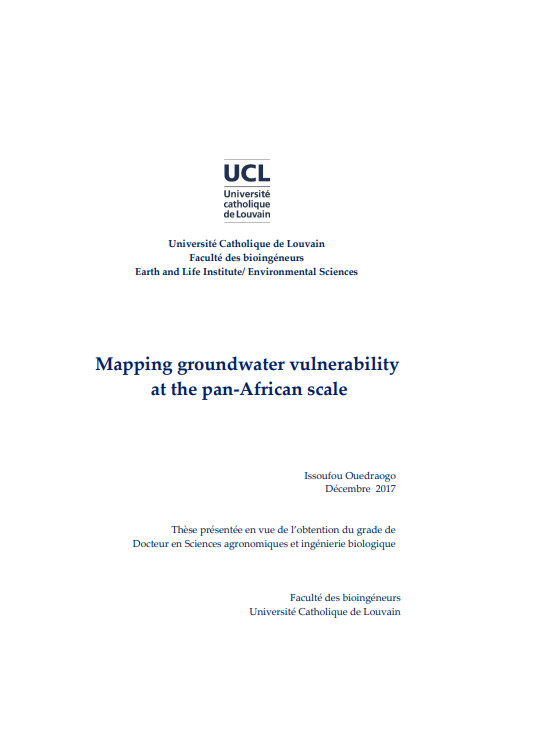Mapping groundwater vulnerability at the pan-African scale
 |
thèse Dec 2017 ; 455 pages
Aut. Issoufou Ouedraogo
Ed. UCLouvain - Louvain-la-Neuve
Téléchargeable sous format: PdF
Téléchargeable chez l'éditeur
 Mapping the groundwater vulnerability for pollution at the pan African scale
Abstract:
Mapping the groundwater vulnerability for pollution at the pan African scale
Abstract:Assessing the vulnerability of groundwater is key to monitor the implementation of the UN Sustainable Development Goal for water. We therefore studied in this thesis groundwater vulnerability for pollution at the continental scale of Africa. The first main objective of the thesis was to map the vulnerability of groundwater to pollution at the continental scale of Africa by applying the generic and standard DRASTIC index model. Best available datasets for land use, soil, topography, geology and hydrogeology were collected from different generic data sources.
These data have been compiled into a 15x15 km2 spatial resolution geodatabase for the African continent and used to build the seven parameters of the DRASTIC vulnerability index. This resulted in the first pan-African groundwater vulnerability and pollution risk map. The map shows that areas under very high and high pollution risk are mainly characterised by shallow groundwater. It is clearly shown that groundwater resources in Africa are subject to pollution pressures.
The second main objective was to develop a data based statistical model for groundwater pollution and to identify environmental variables that explain pollution in groundwater at the pan-African scale. We focussed our work on the nitrate pollution problem, considering that nitrate is proxy of other pollution sources. We compiled a literature based database of nitrate contamination and processed this database by means of a meta-analysis. Two statistical (linear and nonlinear) models were identified to model nitrate contamination of groundwater at the continental scale and demonstrated the unambiguous link between population density and pollution of groundwater by nitrates. We recalibrated and validated these statistical models using regional datasets of nitrate measured in groundwater.
The last main objective was to integrate the time dynamics of pollution phenomena in the modelling approach, focussing on the time dynamics of population density and climate as drivers of groundwater pollution. The implemented approach demonstrated that the groundwater vulnerability to pollution across Africa varies indeed considerably in time, in particularly in densely populated areas in Western Africa, the Nile delta, and urbanised regions in eastern and southern Africa.
Mots clefs: |
gestion de la ressource en eau (CI) (DT) (OP) (ope) , sécurité (CI) (DT) (OP) (ope) |
Editeur/Diffuseur: |
|
UCLouvain
-
Université Catholique de Louvain - Louvain-la-Neuve - Belgique |
En cas de lien brisé, nous le mentionner à communication@pseau.org